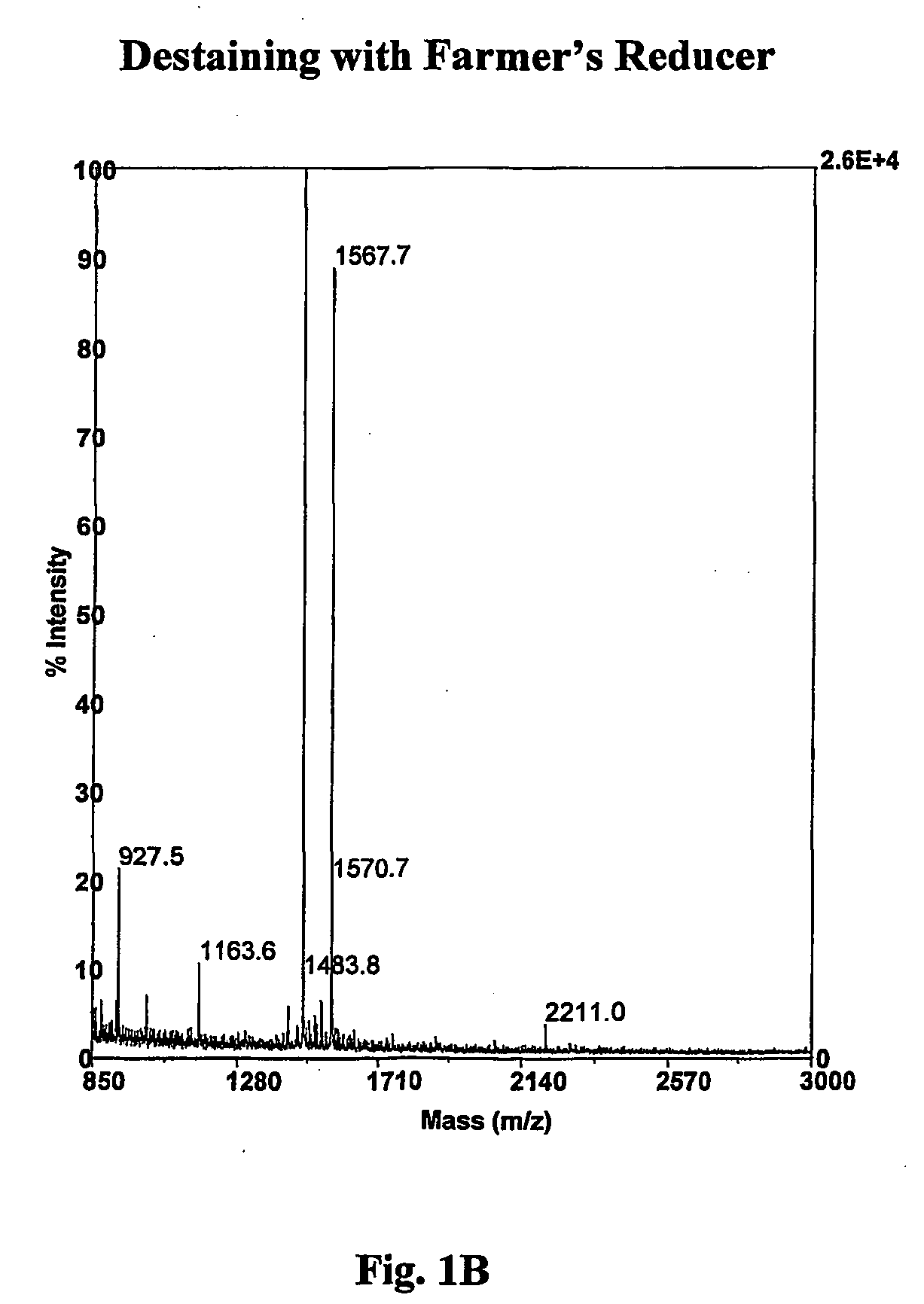Silver destaining method
a silver and staining technology, applied in the direction of fluid pressure measurement, liquid/fluent solid measurement, peptide measurement, etc., can solve the problem of toxicity of potassium ferricyanide used as a farmer's reducing reagent, a very limited solution lifetime of 30 minutes of active farmer's reducing solution, and laborious and time-consuming washing procedure. to achieve the effect of removing transition metal stains
- Summary
- Abstract
- Description
- Claims
- Application Information
AI Technical Summary
Benefits of technology
Problems solved by technology
Method used
Image
Examples
example 1
Comparison of Silver Destaining Methods
[0034] The hydrogen peroxide silver destaining method of the present invention was compared to the Farmer's reducer method and no destaining using model proteins bovine serum albumin (BSA), myoglobin, and glycogen phosphorylase, each separated by one-dimensional polyacrylamide gel electrophoresis followed by MALDI-TOF-MS mass analysis.
[0035] Several PAGE gels loaded with 10, 20, 50, and 100 micrograms of bovine serum albumin were prepared. One-dimensional PAGE was performed according to the procedure of Laemmli (Laemmli, U.K. 1970. “Cleavage of structural proteins during the assembly of the head of bacteriophage T4”Nature 227:680-685) using a Novex X Cell II gel apparatus. Two-dimensional PAGE was performed according to the procedure of O'Farrell (O'Farrell, P. H. 1975. “High resolution two-dimensional electrophoresis,”J. Biol Chem 250:4007-4021) with immobilized pH gradients (IPG) for the first dimension (Görg, et al. 1988. “The current stat...
example 2
Comparison of Silver Destaining Methods
[0042] The hydrogen peroxide silver destaining method of the present invention was used to remove silver stain from PAGE gels visualized with various silver-staining methods including silver nitrate (Shevchenko, et al. 1996. Anal Chem 68:850; Blum, et al. 1987. Electrophoresis 8:93), silver nitrate with tungstosilicic acid (Biorad Silver Stain Plus, Biorad Laboratories, Hercules, Calif.) (Gottlieb, et al. 1987. “Silver staining of native and denatured eucaryotic DNA in agarose gels”Anal Biochem 165:33-37); and Invitrogen SilverQuest™ MS-compatible stain (Invitrogen, San Diego, Calif.). Proteins extracted from Medicago truncatula were used as a protein source.
Proteins and Polyacrylamide Gel Electrophoresis
[0043] Standard proteins including bovine serum albumin (BSA), carbonic anhydrase, lysozyme, and phosphorylase B were obtained from Sigma Chemical Co. (St. Louis, Mo.). Proteins were separated by one-dimensional polyacrylamide gel electroph...
example 3
Effects of Silver Destaining on In-Gel Proteins
[0053] To determine if the hydrogen peroxide silver destaining method of the present invention is detrimental to in-gel isolated proteins, a representative protein gel was prepared, silver stained (Shevchenko, et al. 1996. Anal Chem 68:850-858), destained with hydrogen peroxide and then restained according to the procedures given in Example 2. The results showed that the protein gel could be silver stained, destained, and successfully restained after destaining with hydrogen peroxide without loss of protein due to oxidation or hydrolysis during hydrogen peroxide treatment (FIG. 2A-2C).
PUM
| Property | Measurement | Unit |
|---|---|---|
| mass | aaaaa | aaaaa |
| mass | aaaaa | aaaaa |
| volumes | aaaaa | aaaaa |
Abstract
Description
Claims
Application Information
 Login to View More
Login to View More - R&D
- Intellectual Property
- Life Sciences
- Materials
- Tech Scout
- Unparalleled Data Quality
- Higher Quality Content
- 60% Fewer Hallucinations
Browse by: Latest US Patents, China's latest patents, Technical Efficacy Thesaurus, Application Domain, Technology Topic, Popular Technical Reports.
© 2025 PatSnap. All rights reserved.Legal|Privacy policy|Modern Slavery Act Transparency Statement|Sitemap|About US| Contact US: help@patsnap.com



